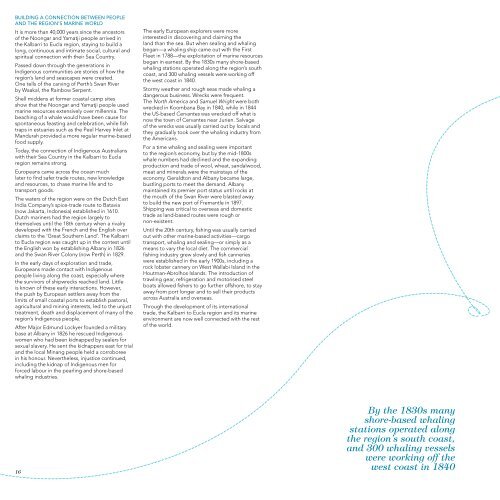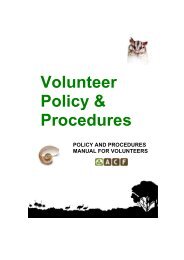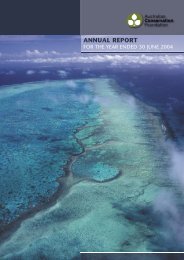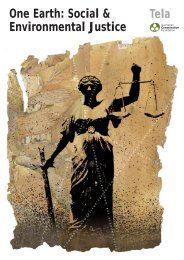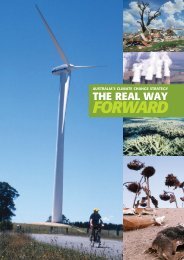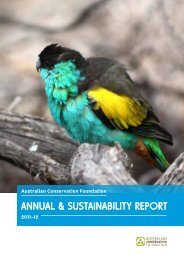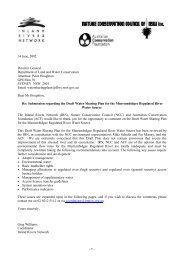Protecting Western Australia's Big Blue Backyard - The Pew ...
Protecting Western Australia's Big Blue Backyard - The Pew ...
Protecting Western Australia's Big Blue Backyard - The Pew ...
- No tags were found...
Create successful ePaper yourself
Turn your PDF publications into a flip-book with our unique Google optimized e-Paper software.
BUILDING A CONNECTION BETWEEN PEOPLEAND THE REGION’S MARINE WORLDIt is more than 40,000 years since the ancestorsof the Noongar and Yamatji people arrived inthe Kalbarri to Eucla region, staying to build along, continuous and intimate social, cultural andspiritual connection with their Sea Country.Passed down through the generations inIndigenous communities are stories of how theregion’s land and seascapes were created.One tells of the carving of Perth’s Swan Riverby Waakal, the Rainbow Serpent.Shell middens at former coastal camp sitesshow that the Noongar and Yamatji people usedmarine resources extensively over millennia. <strong>The</strong>beaching of a whale would have been cause forspontaneous feasting and celebration, while fishtraps in estuaries such as the Peel Harvey Inlet atMandurah provided a more regular marine-basedfood supply.Today, the connection of Indigenous Australianswith their Sea Country in the Kalbarri to Euclaregion remains strong.Europeans came across the ocean muchlater to find safer trade routes, new knowledgeand resources, to chase marine life and totransport goods.<strong>The</strong> waters of the region were on the Dutch EastIndia Company’s spice-trade route to Batavia(now Jakarta, Indonesia) established in 1610.Dutch mariners had the region largely tothemselves until the 18th century when a rivalrydeveloped with the French and the English overclaims to the ‘Great Southern Land’. <strong>The</strong> Kalbarrito Eucla region was caught up in the contest untilthe English won by establishing Albany in 1826and the Swan River Colony (now Perth) in 1829.In the early days of exploration and trade,Europeans made contact with Indigenouspeople living along the coast, especially wherethe survivors of shipwrecks reached land. Littleis known of these early interactions. However,the push by European settlers away from thelimits of small coastal ports to establish pastoral,agricultural and mining interests, led to the unjusttreatment, death and displacement of many of theregion’s Indigenous people.After Major Edmund Lockyer founded a militarybase at Albany in 1826 he rescued Indigenouswomen who had been kidnapped by sealers forsexual slavery. He sent the kidnappers east for trialand the local Minang people held a corroboreein his honour. Nevertheless, injustice continued,including the kidnap of Indigenous men forforced labour in the pearling and shore-basedwhaling industries.<strong>The</strong> early European explorers were moreinterested in discovering and claiming theland than the sea. But when sealing and whalingbegan—a whaling ship came out with the FirstFleet in 1788—the exploitation of marine resourcesbegan in earnest. By the 1830s many shore-basedwhaling stations operated along the region’s southcoast, and 300 whaling vessels were working offthe west coast in 1840.Stormy weather and rough seas made whaling adangerous business. Wrecks were frequent.<strong>The</strong> North America and Samuel Wright were bothwrecked in Koombana Bay in 1840, while in 1844the US-based Cervantes was wrecked off what isnow the town of Cervantes near Jurien. Salvageof the wrecks was usually carried out by locals andthey gradually took over the whaling industry fromthe Americans.For a time whaling and sealing were importantto the region’s economy, but by the mid-1800swhale numbers had declined and the expandingproduction and trade of wool, wheat, sandalwood,meat and minerals were the mainstays of theeconomy. Geraldton and Albany became large,bustling ports to meet the demand. Albanymaintained its premier port status until rocks atthe mouth of the Swan River were blasted awayto build the new port of Fremantle in 1897.Shipping was critical to overseas and domestictrade as land-based routes were rough ornon-existent.Until the 20th century, fishing was usually carriedout with other marine-based activities—cargotransport, whaling and sealing—or simply as ameans to vary the local diet. <strong>The</strong> commercialfishing industry grew slowly and fish cannerieswere established in the early 1900s, including arock lobster cannery on West Wallabi Island in theHoutman-Abrolhos Islands. <strong>The</strong> introduction oftrawling gear, refrigeration and motorised steelboats allowed fishers to go further offshore, to stayaway from port longer and to sell their productsacross Australia and overseas.Through the development of its internationaltrade, the Kalbarri to Eucla region and its marineenvironment are now well connected with the restof the world.16By the 1830s manyshore-based whalingstations operated alongthe region’s south coast,and 300 whaling vesselswere working off thewest coast in 1840Perth’s iconic Cottesloe Beach is partof <strong>Western</strong> Australia’s marine lifestylebut is under threat from predicted sealevel rises caused by climate change© Nico Kenderessy


